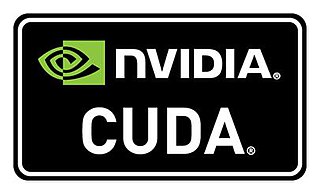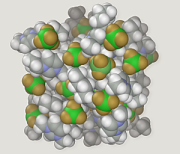 W
WCUDA is a parallel computing platform and application programming interface (API) model created by Nvidia. It allows software developers and software engineers to use a CUDA-enabled graphics processing unit (GPU) for general purpose processing – an approach termed GPGPU. The CUDA platform is a software layer that gives direct access to the GPU's virtual instruction set and parallel computational elements, for the execution of compute kernels.
 W
WA GPU cluster is a computer cluster in which each node is equipped with a Graphics Processing Unit (GPU). By harnessing the computational power of modern GPUs via General-Purpose Computing on Graphics Processing Units (GPGPU), very fast calculations can be performed with a GPU cluster.
 W
WGraphics Core Next (GCN) is the codename for both a series of microarchitectures as well as for an instruction set architecture that was developed by AMD for their GPUs as the successor to their TeraScale microarchitecture/instruction set. The first product featuring GCN was launched on January 9, 2012.
 W
WA graphics processing unit (GPU) is a specialized electronic circuit designed to rapidly manipulate and alter memory to accelerate the creation of images in a frame buffer intended for output to a display device. GPUs are used in embedded systems, mobile phones, personal computers, workstations, and game consoles. Modern GPUs are very efficient at manipulating computer graphics and image processing. Their highly parallel structure makes them more efficient than general-purpose central processing units (CPUs) for algorithms that process large blocks of data in parallel. In a personal computer, a GPU can be present on a video card or embedded on the motherboard. In certain CPUs, they are embedded on the CPU die.
 W
WThe International Workshop on OpenCL is an annual conference that brings together the community of OpenCL users, researchers, developers and suppliers to share OpenCL best practise and help advance the use of the Khronos OpenCL standard for the parallel programming of heterogeneous systems.
 W
WAdvanced Simulation Library (ASL) is free and open-source hardware-accelerated multiphysics simulation platform. It enables users to write customized numerical solvers in C++ and deploy them on a variety of massively parallel architectures, ranging from inexpensive FPGAs, DSPs and GPUs up to heterogeneous clusters and supercomputers. Its internal computational engine is written in OpenCL and utilizes matrix-free solution techniques. ASL implements variety of modern numerical methods, i.a. level-set method, lattice Boltzmann, immersed Boundary. Mesh-free, immersed boundary approach allows users to move from CAD directly to simulation, reducing pre-processing efforts and number of potential errors. ASL can be used to model various coupled physical and chemical phenomena, especially in the field of computational fluid dynamics. It is distributed under the free GNU Affero General Public License with an optional commercial license.
 W
WMolecular modeling on GPU is the technique of using a graphics processing unit (GPU) for molecular simulations.
 W
WNvidia Tesla was the name of Nvidia's line of products targeted at stream processing or general-purpose graphics processing units (GPGPU), named after pioneering electrical engineer Nikola Tesla. Its products began using GPUs from the G80 series, and have continued to accompany the release of new chips. They are programmable using the CUDA or OpenCL APIs.
 W
WOpenCL is a framework for writing programs that execute across heterogeneous platforms consisting of central processing units (CPUs), graphics processing units (GPUs), digital signal processors (DSPs), field-programmable gate arrays (FPGAs) and other processors or hardware accelerators. OpenCL specifies programming languages for programming these devices and application programming interfaces (APIs) to control the platform and execute programs on the compute devices. OpenCL provides a standard interface for parallel computing using task- and data-based parallelism.
 W
WThe Radeon HD 8000 series is a family of computer GPUs developed by AMD. AMD was initially rumored to release the family in the second quarter of 2013, with the cards manufactured on a 28 nm process and making use of the improved Graphics Core Next architecture. However the 8000 series turned out to be an OEM rebadge of the 7000 series.
 W
WAMD Radeon Instinct is AMD's brand of deep learning oriented GPUs. It replaced AMD's FirePro S brand in 2016. Compared to the Radeon brand of mainstream consumer/gamer products, the Radeon Instinct branded products are intended to accelerate deep learning, artificial neural network, and high-performance computing/GPGPU applications.
 W
WSYCL is a higher-level programming model to improve programming productivity on various hardware accelerators. This is single-source domain specific embedded language (DSEL) based on pure C++17. This is a standard developed by Khronos Group, announced in March 2014.
 W
WTesla is the codename for a GPU microarchitecture developed by Nvidia, and released in 2006, as the successor to Curie microarchitecture. It was named after the pioneering electrical engineer Nikola Tesla. As Nvidia's first microarchitecture to implement unified shaders, it was used with GeForce 8 Series, GeForce 9 Series, GeForce 100 Series, GeForce 200 Series, and GeForce 300 Series of GPUs collectively manufactured in 90 nm, 80 nm, 65 nm, 55 nm, and 40 nm. It was also in the GeForce 405 and in the Quadro FX, Quadro x000, Quadro NVS series, and Nvidia Tesla computing modules.